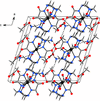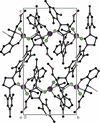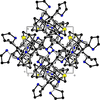issue contents
January 2024 issue

Cover illustration: Robust water oxidation catalysts have been designed that contain a high-valent ion such as FeIV encapsulated by a macro-polycyclic ligand. This report describes the template synthesis and crystal structure of the cage compound diammonium {μ-1,3,4,7,8,10,12,13,16,17,19,22-dodecaazatetracyclo[8.8.4.13,17.18,12]tetracosane-5,6,14,15,20,21-hexaonato}ferrate(IV) acetic acid trisolvate, (NH4)2[FeIV(C12H12N12O6)]·3CH3COOH. The unusual oxidation state FeIV is stabilized by the encapsulation by six deprotonated hydrazide nitrogen atoms, with a coordination geometry intermediate between a trigonal prism and an antiprism. This is the first hexahydrazide complex with point group symmetry C2 for the anion instead of the usual C1 symmetry. See: Plutenko, Shylin, Shova, Blinder & Fritsky [Acta Cryst. (2024). E79, 25–28].
research communications




























Crystal structure and Hirshfeld surface analysis of 3-benzyl-2-[bis(1H-pyrrol-2-yl)methyl]thiophene







 journal menu
journal menu





































